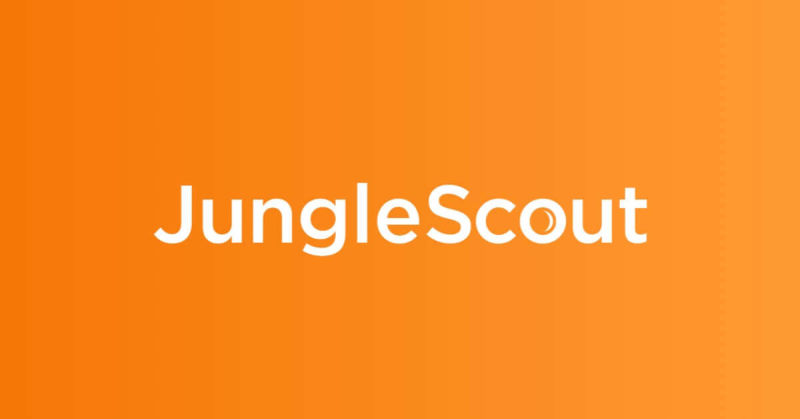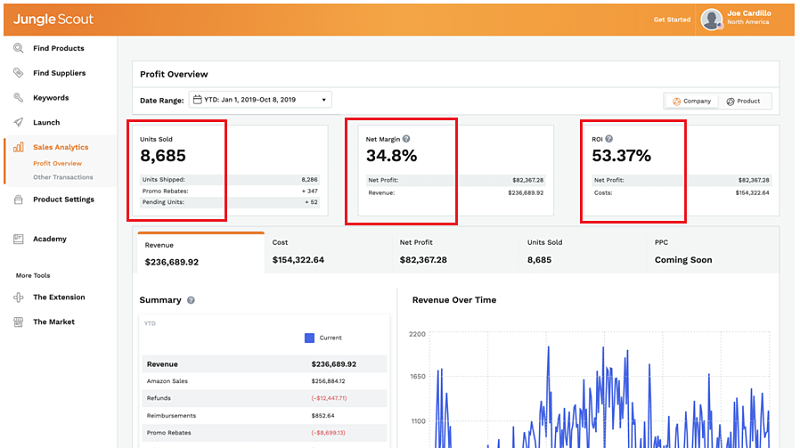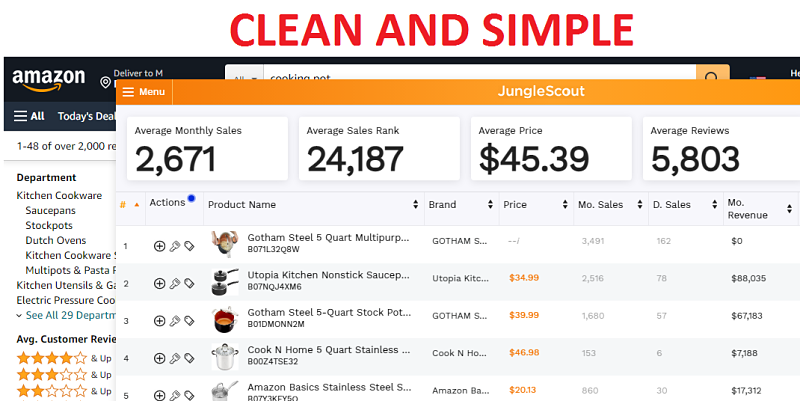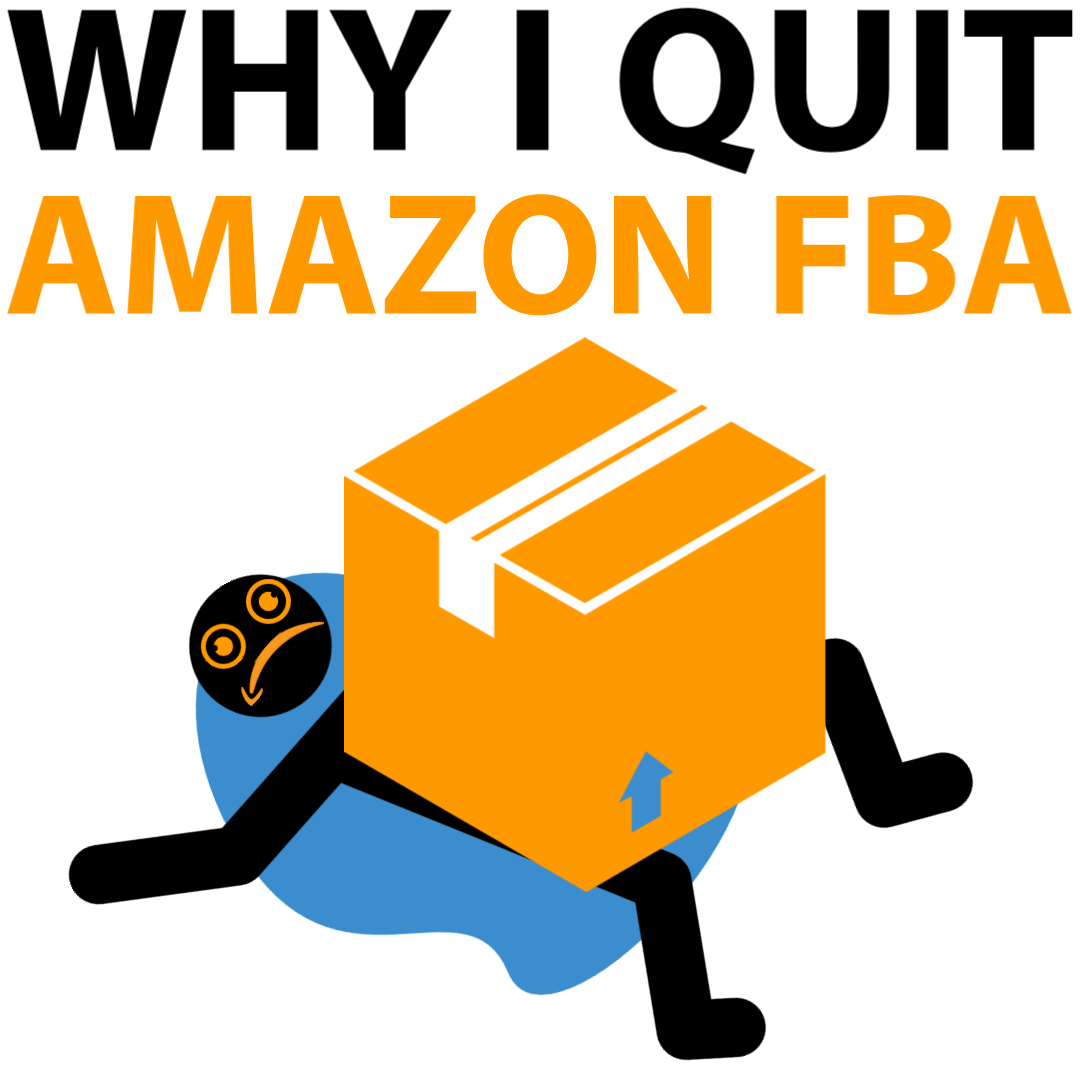Looking for an in-depth Jungle Scout Review?


Ok let’s get right to it.
You’re here cos you're looking for an in-depth Jungle Scout review, right?
In other words, you wanna get the lowdown on the tool, and see if it's the real deal!
As a 6-figure Amazon seller, I’ve been through dozens of courses and tried dozens of tools to make sure my business is always firing!
I’m obsessed with growing my income, and I’ve done this in both my Amazon FBA business as well as my Local Lead Generation business, which is now making me a consistent $30K a month.
One of the Amazon tools I’ve been looking at is the ever popular Jungle Scout.
As one of the big dogs on the market, they’ve got an army of raving fans.
That’s cool... but I wanted to dig into the tool and find out if it will actually help me make money on Amazon.


I’m also gonna do a deep dive into some of the hidden secrets of selling on Amazon, that only a 6 figure seller would know...so make sure you read all the way to the bottom.
Stick with me cos here’s what you’re gonna learn in this review...
Let’s roll up our sleeves and get going...
1. WHAT IS JUNGLE SCOUT?
So if you’re reading this, I’m gonna guess you’ve heard of Jungle Scout.
Great.
But what you may not know is that Jungle Scout is way more than just a Product Research tool.


In a nutshell, the tool is designed to help sellers like you and me win on the world’s biggest shopping platform (Amazon of course).
This means being able to easily find better products that will give us the best chance at success.
Then once we’ve found them, helping us launch and promote them the right way, as well as allowing us to keep tabs on our business numbers, making sure we’re firing on all cylinders.
2. DO I NEED JUNGLE SCOUT?
As someone that’s been selling on Amazon for a number of years, I’ve got a pretty good idea as to what a good Amazon product looks like.
Here are a few things you’re gonna want to focus on if you’re just starting out in the Amazon game.
So now that we know what makes up a good first product, here’s how Jungle Scout can help you find it.
Ideally you’ll want to have a product idea in mind when you first start using the tool.
Then once you fire it up, you’ll want to pay careful attention to metrics such as price, demand, competition and monthly sales.


We’ll do a deeper dive into how you’ll pull out these metrics in the features section below.
For now though, know that using the Jungle Scout tool will help you cut through the weeds, and be able to make much better business decisions, before you pull the trigger on a $10K inventory order (Yikes!!!).
3. JUNGLE SCOUT FOUNDERS: Who is Greg Mercer?
Jungle Scout was founded by Greg Mercer, who also just happens to be an Amazon 8 figure seller.
Of course, this is no coincidence.


Greg founded Jungle Scout out of sheer frustration, after he identified a need for a better way to do Product Research.
Up until that point, he was forced to carry out this type of painstaking research manually.
Hours upon hours of manually trawling through product categories, comparing the top products against each other in spreadsheets, looking for a gap in the market.
He knew there must be a better way, not only for himself, but for the millions of other Amazon sellers just like him.
With that, Jungle Scout was created, and it instantly relieved the pain and struggle of manually crunching Amazon data.
This was back in 2014.


Fast forward several years and the Jungle Scout tool is now an impressive suite of sub tools, all designed to make selling on Amazon just that much easier.
All in all, I gotta say I love Greg’s vibe.
He just seems like an awesome chilled out dude, that’s on a mission to add value to the planet.


In my opinion, this is one of the biggest things that successful entrepreneurs have in common…
They focus on adding value first, knowing that the money will follow after!
4. JUNGLE SCOUT EXTENSION FEATURES
One of the slightly confusing things about Jungle Scout is that it's split into 2 parts.
The web app and the extension.
The web app is where the majority of Jungle Scout’s features are found, and where most of the number crunching is done (more below).
The extension on the other hand, is a Chrome plugin that loads in your browser whenever you’re on any of Amazon’s pages.


It then scrapes any data on that page, and returns it neatly in a presentable format that you can use to analyse the competition.
You’ll see information such as price, rank, category, revenue, reviews, rating, seller type (FBM, AMZ or FBA) and a few other columns.
The extension is awesome, and I found it really simple to use.
Best of all, you’ll save countless hours using it, as you won’t need to scrape all the data, product by product yourself, and run it through endless spreadsheets.


By clicking the icon at the top right of the screen in the Jungle Scout extension, you’ll see all this information in a flash.
5. JUNGLE SCOUT WEB APP FEATURES
As we now know, Jungle Scout is a lot more than a tool for doing Product Research.
Of course, it’s pretty good for that, but there’s a lot more under the hood of this engine.
The Product Database: With literally millions and millions of products loaded into the database, you’ll be able to apply a set of filters that will weed out any products that don’t meet your requirements, and leave you with the cream of the crop.


Sounds simplistic right?
Don’t underestimate the power of the ability to do this.
Think of it like looking for a needle in a haystack.


Apply the right filters, and you’ll be left with exactly the products that meet the spec...from a data set of 500 million.
Keyword Research: With Keyword Scout, you’ll be able to get insight into the keywords shoppers are actually using when they search for products like yours.
This will help you ensure that there is actually demand for your product, and that your listing is optimized for the right keywords that will drive traffic to it.


You’ll be able to assess the actual keywords that shoppers use, and how often they use them (demand).
What was super cool about this feature is that most sellers are able to think of the main obvious keywords for their product, but that's usually where it ends.
Keyword Scout spits out dozens of additional long tail keywords too.
You'll find that these are much easier to rank for, and will collectively send a constant stream of traffic to your listing.
This will allow you to add them to your PPC campaigns, to ensure you get the best conversion rates.


Product Tracking: The product tracking feature allows you to simply add products to the tracker tool as you browse them.
You’re then able to see the complete sales history of the product, as well as real time data such as Best Seller Rank, Price, Units Sold, Reviews and Inventory level.
Opportunity Finder: The Niche Hunter tool is a little bit like the product database module, although it crunches data at category level, rather than product level.


You’ll be able to apply a range of filters, and then get results based on Category, Competition, Listing Quality (how easy it is to outrank them), Average Price, Opportunity Score.


Finding Suppliers: Hands down one of the scariest parts of starting an Amazon FBA business, is sucking up the courage to wire $10K over to a supplier for stock you’re not even sure exists.
I mean at the end of the day, how do you know they aren’t just a scam artist, ready to take your money?


The Jungle Scout team helps with that, by allowing you to search through their supplier database, knowing that they are all vetted and approved.
While nothing in life is guaranteed, this takes a large part of the risk out of working with a supplier you don’t have a relationship with.
Sales Data Module: This is another pretty cool feature which allows you to plug your version of Jungle Scout directly into your Seller Central account.
This then allows you to be able to see all your sales data, in a format that’s much easier to read than anything the Seller Central platform dishes out.


Winning the game of selling on Amazon requires that you keep a close eye on your numbers, and this module lets you do this, quickly and easily.
Inventory Tracking: As you’ll now have your Jungle Scout account connected to your Amazon selling account, you’ll also be able to make use of the Inventory Tracking feature.
This gives you the big picture on your inventory, letting you know when you need to reorder, and what it will cost you.


You’ll also be able to see your reorder profits and ROI, all while being guided by the Jungle Scout algorithm which will accurately predict when you need to place your order based on your sales history, and products past trends.
Listing Builder: The listing builder allows you to ensure that your listing is perfectly optimized, just the way Amazon likes it.


You’ll be able to build out each section of your listing, and make sure that it has rich content that will not only get traffic to your listing, but will also convert it into customers.
Launch Module: Jungle Scout’s Jump Send feature allows you to offer your product to a hungry market, looking for discounted offers.
Why does this matter?


Well put simply, it will get you making sales right out the gate, meaning that Amazon will take notice of your product and start ranking it organically.
There are a number of different factors that go into Amazon’s ranking algorithm, but one of the biggest is sales velocity.


In other words, the amount you sell, and the time that it takes you to do it matters.
6. PRICE: How Much Does Jungle Scout Cost?
When it comes to price, Jungle Scout keeps it clear and simple to understand.
The extension sets you back $29 a month provided you’re happy to pay for the year upfront.
As with most products and services, you’ll get a better price if you pay for 12 months, as opposed to on a month to month basis.
![JS Prices]_opt Jungle Scout Price](https://socialcrawlytics.com/wp-content/uploads/2021/02/JS-Prices_opt.png)
![JS Prices]_opt Jungle Scout Price](https://socialcrawlytics.com/wp-content/uploads/2021/02/JS-Prices_opt.png)
If you want to get stuck into the web app, you’ll need the Suite option which costs $49 a month on the annual plan.
This gets you access to most features, but is for a single user.
If you’re in need of multiple users, then the Professional option at $84 will be the package you’ll need to get.


This allows you to have a team of 6 users access the tool under the same license, plus a few extra bonus features such as 2 years historical keyword data, 6 months of historical data in Product Tracker, and even priority on boarding.
You can also add additional users for a fixed fee per month.
Overall, I thought Jungle Scout was well priced.
It’s not the cheapest product on the market, but it’s also certainly not the most expensive.


For what you’re getting and considering you’re using a tool to run a full blown business that could do 6 figures, I couldn't complain!
7. USER EXPERIENCE: How Easy is Jungle Scout to Use?
Overall, the Jungle Scout team does an amazing job when it comes to creating an awesome user experience.
First up, the overall color scheme and branding is right on point, creating a warm inviting feeling.


The tool is really well laid out and I found it intuitive as hell to use.
The support crew provided some solid training videos, but I honestly didn’t feel like I needed to use them, as everything seemed to make sense.
In each module / tool, I found that the data displayed was done so in a way that made it super simple to read and then apply to my business.


I’ve used other tools in the past that have worked well, but the user interface has been messy, which has made it difficult to interpret the data being returned.
Not the case when it comes to Jungle Scout.
8. JUNGLE SCOUT SUPPORT AND CUSTOMER SERVICE
One of the things I like most about Jungle Scout is that you get the feeling they are more than just an Amazon FBA tool.
With Greg’s leadership, they come across as a family that really care about their customers.


It’s almost like they’re on a relentless mission to help Amazon sellers and the money is just a byproduct of them doing a great job.
This is clear in their attentive customer support, which really goes above and beyond.


After having some issues getting my Chrome extension to work, they answered my cry for help quickly and solved the issue in a few minutes.
As simple as this may sound, it only takes dealing with a company that doesn't provide good customer support to appreciate one that does.
9. JUNGLE SCOUT FEEDBACK AND REVIEWS
When it comes to customer feedback and reviews, Jungle Scout does a pretty solid job.
With over 2,000 reviews on Trustpilot, and a rating of 4.5, it’s clear they have an army of raving fans.


Considering that Trustpilot is just one of the many review platforms available, and that usually less than 5% of users will leave a review, achieving 2,000 + reviews is a pretty impressive feat.
Overall, Jungle Scout customers seem happy with their purchase, and while some may question the long-term use of the tool (once you’ve got your product selected etc.), people generally love it.


10. JUNGLE SCOUT PROS AND CONS
11. IS JUNGLE SCOUT WORTH IT?
Ok so at the end of the day, it all comes down to one question.
Will Jungle Scout help me make money on Amazon?
The short answer….YES!


If you’re new to the game of Amazon, or even if you’re well versed in Amazon selling practices, you stand a much better chance of success if you’ve got this tool in your bag of tricks.
You'll have the ability to find products that meet strict filter guidelines, keep an eye on competitors and trends, and of course drill into hidden keywords that other sellers might not be utilizing.
You'll also be able to keep a close eye on inventory levels and sales analytics, which is invaluable in my opinion. (inventory management is hard)
Most of all, it's proven to be the most accurate Amazon tool on the market, which as an Amazon seller I can confirm.


Put it this way…
If Jungle Scout can’t help you make money on Amazon, then nothing can.
So does that mean you’re guaranteed to make money if you use Jungle Scout?
...Sadly not.
In-fact, there’s a whole dark underworld to selling on Amazon that most newbies don’t know about.


As a 6 figure Amazon seller myself, I kinda feel like I owe you the truth about what it actually takes to sell on the platform…
(hint: It’s about to get messy)
12. THE DIRTY TRUTH ABOUT SELLING ON AMAZON: Read Before Starting Your FBA Business
Ok time to get real…
It’s one thing to know about a cool Amazon tool like Jungle Scout, but there’s a lot of dirty secrets when it comes to selling on Amazon, that you ain’t gonna hear from someone selling an Amazon course or tool.


Sure, you can make good money playing the FBA game, but here’s what you need to know before you get started.
The good old days of the Amazon Wild West (pre 2014) are long gone.
Back then, you could almost throw up any product and it would sell.
That’s all changed now, and it’s getting tougher and tougher to view this business as a reliable income source.
Here’s why…
Did you know that every year, over 1m new sellers join the Amazon game.


Here’s where it gets really scary though...a large number of these new sellers are Chinese companies that actually manufacture the product themselves.
So why does that matter?
Well, because they make the products themselves, they can list them for sale on Amazon for a much lower price than you and me.
In other words, there’s no middle man.
One of my main products went from having an average category price of $19.99 to just $11.99 in a few years.


Why?
Because companies that make the product are listing it for sale on Amazon and undercutting the market on price.
That means that the rest of us have no choice but to either drop our price or go out of business.
Take it from me, price wars are no fun, and it seems like with all other sellers dropping their prices, it’s a race to the bottom, which is where no one wants to be.
You’re also gonna find that you probably need a lot more capital to get your business started than you think.
Let’s say you’re just starting out and you think you’ll order 500 units of a product from a supplier for $5 a unit.
That’s $2,500...not too bad, right?


Stick with me, because here’s where it starts getting a little messy.
What most people don’t realize is that the average order will take around 90 days from start to finish until it lands in Amazon’s warehouses.
In most cases, you’re usually looking at around 30 days for manufacturing, and 60 days shipping.
So why is this a factor?
Well because even if you placed your 2nd order on the same day that you started selling on Amazon, your next order will still be 90 days away from arriving.
That would mean your current order of 500 units would have to last you 90 days, else you’ll run out of stock.
That means you can only sell 6 units a day…
Not exactly setting the world on fire is it?


Running out of stock on Amazon is a cardinal sin.
Not only are you losing potential income, but your listing loses its ranking and you’ll find that all your launch efforts to get to the first page of Amazon are wasted, as your listing slides down to page 2, 3 or beyond.


This means that once you’re back in stock, you’ll need to consider running another launch, or expensive PPC advertising in an attempt to drive traffic to your listing.
So how do you avoid running out of stock?
You’ll need to either place a larger 1st order, or you’ll need to chase your 1st order with a 2nd and even 3rd order...
...All before you even start selling your product.


This will ensure that your Supply Chain runs smoothly to factor in the 90 day lead time.
So instead of costing $2,500 to get your business started, you’re now looking at another $5,000 (2 extra orders), for a total of $7,500.
Then add in shipping (usually at least $1,000 per order), and you’re now needing more than $10K.


Throw in PPC advertising, launch giveaways, Amazon warehouse fees, and the reality is that instead of needing $2,500 to start your FBA business, you’ll actually need closer to $15,000!
….and guess what?
You don’t even know if anyone is going to buy your product!
Talk about a rocky foundation to start your business on.


The other thing I’ve become more aware of during my time selling on Amazon, is just how little control I have over my own business.
Think about this…
What if my supplier sends me 3,000 faulty units that ship directly into Amazon’s warehouses?
I’d never know they were faulty and they’d start selling on Amazon.
I imagine it wouldn’t take long for customers to start leaving 1 star reviews and returning the faulty product.


In the space of a few weeks, my entire Amazon listing could be decimated, and my business would go right down the drain.
What if competitors keep dropping their prices, eating into my already slim profit margins?
What if Amazon increases their warehouse fees?
What if the shipping company I use increases their rates?
What if Amazon bans my selling account and I’m left with thousands of inventory units I can’t sell?


Do you see how little control you actually have over your Amazon business?
Once I realized this, I knew I had to find a more reliable and stable business model, that I could build my family’s future on.
Amazon FBA just wasn’t going to cut it for me!
13. MY #1 BUSINESS MODEL: Lead Generation
Fortunately I found another business model, which I personally think is one of the best models on the planet.
Introducing local lead generation.


With local lead generation, you’re building little websites for local services like carpet cleaning, plumbers, tree services etc. and then ranking them in Google.
Here’s the lowdown on how it works…
Let’s say you build a tree service website for a local town in your area.


You rank it #1 in Google, and then drop a call tracking phone number on it.
When people start finding your website and calling the number looking for a tree service company, you then direct the number to a local tree service company who takes the calls.
They then pay you for all the leads you’re sending them.
This could be a fixed fee per month (say $750), pay per lead (say $20 per lead), or a commission deal (say 10% per job).


The cool thing about this model is that you can build as many of these sites as you want.
Do you see the potential here?
Imagine you had 10 sites earning $750 a month each?
Imagine you had 100 sites earning $750 a month each?
Imagine you had 1,000?




MARKET SATURATION & COMPETITION


You're going head to head with literally millions of sellers covering over 6000 different product niches. Breaking into an established niche is next to impossible - and finding untapped niches are becoming increasingly rare.


Start up costs require roughly $5000 in initial inventory, $10,000 in advertising, and $3000 in listing optimization, packaging, and branding. All in all, if you want to have a chance at success, you'll need to spend roughly $15,000 to $20,000 just as an initial investment.


Nearly all successful products are copied and resold by either Amazon or Chinese manufacturers who then undercut their competition at margins that only billion dollar companies can afford. Every time you see an Amazon Basics or Essentials product at the top ranked listing, it's likely that dozens of independent sellers went out of business.


The key to long term wealth is in building and owning valuable assets, but with Amazon FBA, you own nothing. You're an enslaved middleman to Amazon, who care only about market domination and making a profit. Remember, you're there to make them money - and your use of Amazon is a privilege they grant you; a privilege they can revoke at any time.


Between identifying products and suppliers, passing quality assurance, securing inventory, and then product ranking, you're looking at over a year before you even have a chance at seeing a net positive income.


Profit margins are extremely low, meaning the only real way to make money is through mass ordering. Successful Amazon sellers often make less than 10% profit off of their sales.


Amazon's terms of service are fickle and ever changing. Bans are frequent and can spell disaster for FBA startups and established businesses alike.


























Local Lead Generation
Schedule your coaching call today